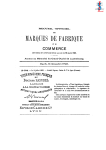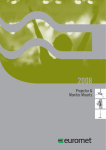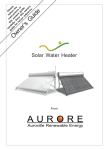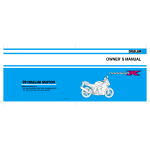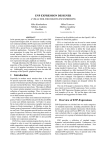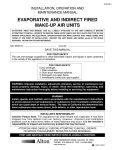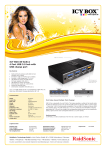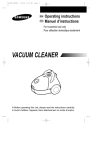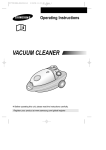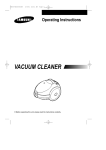Download Operating instructions - Ecobuild Product Search
Transcript
For more information go to www.ecobuildproductsearch.co.uk Operating instructions c i4 www.contura.eu For more information go to www.ecobuildproductsearch.co.uk GB 18 OPeRaTiNg iNSTRucTiONS air inlet controls choice of fuel To ensure correct and complete combustion it is important to follow the instructions for the two air supply controls, they must be used differently depending on what type of fuel is used. NOTE! the primary air inlet control can only be regulated if the grate is in open position, to open the grate pull the grate hadle towards you. This appliance is a multifuel stove and can be used with both wood logs or smokeless fuel. All sorts of logs, such as birch, beech, oak, elm, ash, conifers and fruit trees can be used as fuel in the stove. Different types of wood have different density, the higher the density the higher the energy value. Oak, beech and birch have the highest density. When using smokeless fuel remember to burn only anthracite or manufactured smokeless fuel briquettes. Never use bituminous coal or petroleum based fuels, these types of fuels will invalidate the product guarantee. The lighting is highly recommended to be made with kindling wood irrespective of which type of fuel you are using. Burning wood: Always set the primary air inlet control to the closed position and control the combustion with the secondary air inlet control. Burning smokeless fuel: correctly sized wood Control the combustion with the primary air inlet control and set the secondary air inlet control to the closed position. Note that if too little kindling is used when lighting, or if the wood is too thickly cut, the fire box will not reach the correct operating temperature. Incorrect lighting can lead to poor combustion with heavy sooting and may result in the fire going out when the door is shut. Secondary air inlet control Closed Max open Kindling wood: Finely chopped wood Length: 20-25 cm Diameter: 3-4 cm Weight per lighting: 1.5 kg (approx. 12-15 finely chopped pieces) Feeding Wood: Chopped wood Length: 20-25 cm Diameter: 6-7 cm Normal weight: 1.0 kg/hour (1-2 logs per load) Max weight: 1,5 kg/hour (1-2 logs per load) Feeding Solid fuel: Anthracite or manufactured smokeless fuel briquettes Grate handle ed Clos Normal weight: 0,6 kg/hour Max weight: 0,9 kg/hour Ope Operating the right way ! It is important that the correct amount of fuel is used, the amount of air supplied will not be enough if you overload the stove. It is especially important that the correct amount of wood is used, when lighting. If you are lighting the fire for the first time you should use a scale to see how much 1,5 kg kindling is. Also check what the normal and maximum weights look like. The stove is only intended for use with the door closed and it is only then that the hot air flushing of the glass surfaces occurs. Always open the door carefully and slowly to prevent blow back because of the changing pressure in the stove. The function of stoves differs depending on the draught conditions in the chimney. Achieving the correct setting for the combustion air damper usually takes a few attempts. n Primary air inlet control Closed Max open lighting If your house has mechanical exhaust air ventilation you will need to open a window near the stove before lighting the fire. Leave the window open for a few minutes until the fire has caught. 1. Close the primary air control and open the secondary air control fully. 2. Place some newspaper or a fire lighter block, and approximately 1,5 kg kindling in the middle of the stove. The wood should be piled alternately across and lengthways. 3. Light the fire. 4. The door is set to the lighting position, that is when the locking hook is set to leave the door slightly open. When the fire has caught fully after approx 10-15 minutes, close the doors completely. The first load of logs should not be put on until the start up fire has become a glowing bed of embers. For more information go to www.ecobuildproductsearch.co.uk Wood loading 1. Open the door handle slightly and let the vacuum in the firebox equalise for a few seconds before opening the door completely. 2. Add 2 logs of a combined weight of approx 1.0-1.5 kg. One log is placed diagonally and the other one placed parallel to the back. Then close the door. Leave the air inlet control completely open for approx. 5 minutes until the logs turn black and catch fire. 3. If you wish slower combustion, the supply of air inlet can be reduced. Nominal output of 4 kW is usually obtained when the air inlet control is set to 50% open and two logs are lit. In this operating mode it is important that the air inlet control is fully open for the first 5 minutes so that the wood has a chance to ignite fully before the supply of from the air inlet control is reduced. A condition of being able to control the heat output is a thick bed of embers and a high temperature in the firebox. When the fire has burnt down to embers is the time to add more wood. The conditions for controlling combustion vary depending on the temperature in the stove and the draft in the chimney. Smokeless fuel loading When using smokeless fuel the grate shall always be in open position, this is reached by pulling the grate towards you. It is only when the grate is in open position you are able to adjust the primary inlet air control. 1. Set the primary air control to the right, this will give maximum of air supply towards the grate. 2. Close the secondary air inlet control. 3. Add 0,6 kg of briquetts on top of the glowing embers and close the door. 4. After approx. 5 minutes when the fuel is well alight, open the door and place the primary air control at 50 % open, this will under normal conditions give you the nominal output of 4 kW. De-ash before refueling, refuel little and often for clean and efficient burning. Always burn new fuel at high output for a few minutes before you adjust the primary air control into desired setting. Remember not to burn with the primary air control at maximum for longer periods. Quick lighting It is important that the wood catches fire quickly. Quick lighting is achieved by opening the combustion air damper fully or by leaving the door in the lighting position for a moment. Smouldering, i.e. reduced air supply, results in poor combustion and efficiency with high emission discharges and can, in worst-case scenarios, cause rapid gas ignition resulting in stove damage. The wood’s moisture content Fresh wood is about 50 per cent water. Some of the water circulates freely between the fibres and some of the water is bound in the cells. The wood must always be dried so that the free water evaporates. The timber is ready for use when the moisture content has fallen below 20 %. If wood with a higher moisture content is lit, a large part of the energy content of the wood is used boiling off the water. If the wood is damp, the combustion is also poor, layers of soot and tar build up in the chimney and could, at worst, lead to a chimney fire. In addition, it causes the glass of the stove to soot and may cause discomfort to those living nearby. To ensure thoroughly dry wood, the wood should be cut in the winter and stored, well aired, under a roof. Never cover the wood pile with a tarpaulin to the ground. The tarpaulin will then act as a sealed cover and the wood will be prevented from drying. Always store a small amount of wood indoors for several days before use, so that the surface moisture has time to evaporate You must NOT burn the following Under no circumstances may bituminous coal or petrolium based solid fuel briquettes be used. Neither pressure impregnated wood, painted or glued wood, chipboard, plastic or colour brochures be used as fuel. All these materials can create hydrochloric acid and heavy metals that are damaging both to the environment and the stove. Hydrochloric acid can also attack the steel in the chimney or the mortar in a stone built chimney. Stove maintenance The glass may be come sooty with use, even if the fire is lit with dry wood with a moisture content of 15-20%. Wiping with dry paper is often sufficient when cleaning regularly. If the soot has been on the glass for longer it can be removed using cleaning agent or a specific soot removal agent. When antrhacite smokeless fuel are used and the glass air wash is reduced you will likely have stain on the glass, this will easily be removed with some cleaning agent. These cleaning agents can be purchased at your local supermarket or your local stove dealer. Never use cleaning agents that contain any abrasives, these can damage the glass. Ensure that no embers remain when removing ash from the stove. The ash must be stored in a fireproof container with a lid for for at least a week before being disposed of. The grate and other cast iron components can be cleaned using a wirebrush. It is important that the gaskets are checked from a combustion point of view, because worn gaskets reduce combustion because the stove draws additional air. Painted parts of the stove can be cleaned with a damp cloth and, if necessary, a little washing-up liquid. Damage, such as scratches, to painted parts can be repaired using Contura touch up paint. Contact your dealer. Components close to the centre of the fire may need to be replaced. Examples of such components are the stove cladding and grate. The life of these components depends on how much and in what way the stove has been used. Hearth plate glass must be discarded as waste material together with pottery and porcelain GB 19 For more information go to www.ecobuildproductsearch.co.uk GB 20 AVOID TOO LARGE A FIRE The fire should not be too big. Large fires are uneconomic and also produce high smoke temperatures that can damage the stove and the chimney. The recommended amount of wood is 1.0 kg/hour and the maximum permitted is 1,5 kg/hour and then refers to burning split birch or other broadleaf wood with 18% moisture content. When lighting the same weight of conifer wood, significantly higher stove temperatures are reached. The recommended amount of anthracite or manufactured smokeless briquettes is 0,6 kg/h, maximum amount is 0,9 kg/h. Maximum fire for long periods reduces the life of the stove and exceeding the permitted fuel amounts can lead to damage to parts of the stove and the warranty being invalidated. POSSIBLE CAUSES OF OPERATIONAL INTERFERENCE AND HOW TO RECTIFY THEM Poor draught in the stove after new installation • Check the length of the chimney so that it meets Contura’s recommendations, that is a total length of at least 3.5 metres. • Check that there is nothing in the chimney to restrict the smoke and that no nearby buildings or trees affect the winds around the chimney. • Check the area of the chimney (applies to existing stone built chimneys), which should be 120-200 cm². It is difficult to light the fire and the fire dies after a short time • The wood may not be dry enough, check the wood. • Another reason is that there may be negative pressure in the house, for example when using a kitchen extractor fan or other mechanical ventilation. Open a window near the stove before lighting the fire. Also try lighting some newspaper and holding it up inside the stove to get the draft going. Abnormal amounts of soot form on the glass when using wood There is always a certain amount of soot on the glass and this is added to with each lighting. Soot on the glass is caused by three things: • The wood is damp, which causes poor combustion and generates a lot of smoke as a result. • Too low temperature in the firebox, which causes incomplete combustion and poor draught in the chimney. • Incorrect procedure, the door was not in the lighting position for approximately 15 minutes. Check the moisture content of the wood, ensure that you have good base embers and go through the lighting instructions once again. Smoke odour around the stove for periods This can occur when wind blows down the chimney and most often occurs when the wind is from a particular direction. Another cause is the door was opened when it is burning hard. Painted parts have become discoloured If painted parts have discoloured it is due to an excessive temperature in the stove. The reason for the excessive temperature can be that the maximum amount of fuel has been exceeded, inappropriate fuel has been used (for example building waste, large quantities of finely chopped off cuts). The warranty does not cover damage of this type. If a problem occurs that you cannot rectify yourself, contact the dealer or a chimney sweep. We hope that these words of advice will help you to enjoy pleasant, economic and problem free use of your Contura stove. • The air supply duct from the outside may be completely or partially blocked. Disconnect the hose and try lighting the fire with combustion air from the room. • Perhaps one or both of the combustion dampers are in wrong position, see operating instructions. • The smoke outlet of the stove may be blocked with soot, which can occur after sweeping. Lift the smoke baffle out and check. • Finally go through the lighting instructions again. Perhaps the amount of kindling was too small and therefore the base embers were too weak and cold to light the next load of wood. Warning SWEEPING Sweeping the chimney ducts and chimney connections should be carried out by a chimney sweep. The stove can be scraped down and/or swept. A soot vacuum cleaner is most appropriate however. If a chimney fire occurs or is suspected, the combustion damper and the door must be closed. If necessary, contact the fire brigade to extinguish it. The chimney must always be inspected by a chimney sweep after a chimney fire. • During operation, certain surfaces of the stove become very hot and can cause burn injury if touched. • Be aware of the strong heat radiated through the hatch glass. • Placing flammable material closer than the safe distance indicated may cause a fire. • Smouldering can cause quick gas ignition with the risk of damage to property and personal injury. NIBE AB · Box 134 · SE-285 23 Markaryd · Sweden www.contura.se 811164 BAV C i4 SE-EX-1 2012-01-31 Contura reserves the right to change colours, materials, dimensions and models at any time without special notice. Your dealer can give you the most up to date information. Stoves shown in brochures may have extra equipment.




